Transmedia design is more than reposting the same story across platforms. It’s about creating a connected universe where each medium contributes something unique to the audience’s experience. Think of how Marvel films, TV series, comics, and video games expand a shared world—each adding a new piece of the puzzle. That’s the level of storytelling power we’re preparing creators for on The SM Dial.
If storytelling is the heart of The SM Dial, transmedia is the bloodstream. At the Los Angeles Film School, I took a course called Transmedia Design that reshaped how I see the future of entertainment—and it now fuels everything we’re building.
In the course, we studied how to adapt stories across formats—how a single idea could become a podcast, an interactive video, a social media series, and even a live event. What struck me most was this idea: you’re not just building content, you’re building worlds.
I remember mapping out a story arc that would begin as a short film, expand through character-driven Instagram posts, and conclude with a real-time chatbot experience. It was the first time I realized how tech and story could co-create meaning, not just distribute it.


Storytelling isn’t bound by format—it’s powered by intention.
The course also challenged us to design entry points for different types of audience members—because not everyone experiences a story the same way. Some start with a tweet. Others jump in through a livestream. Some stay for the comment section. Transmedia makes room for all of them. That lesson became a blueprint for how I want to serve communities on The SM Dial: accessible, layered, and personal.

Leave a Reply